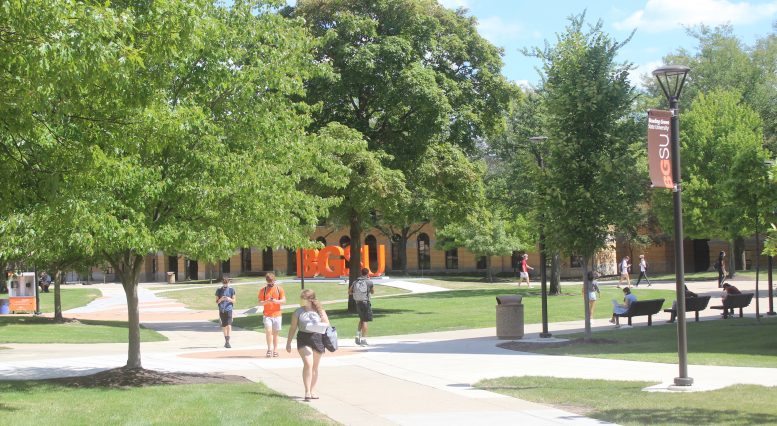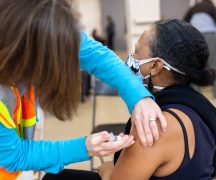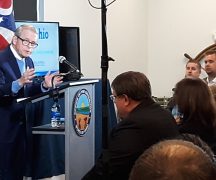By DAVID DUPONT
BG Independent News
A fog of uncertainty remains a week after Bowling Green State University has resumed classes.
Tuesday (Sept. 2) at the first Faculty Senate meeting of the semester President Rodney Rogers, Chief Health Officer Ben Batey and Provost Joe Whitehead spent 40 minutes responding to questions that have been posed by faculty.
Many of those queries came through anonymously. Andrew Schocket, of the Department of History, said earlier in the summer when Rogers was holding virtual sessions, he started soliciting questions on the faculty discussion group. “It was clear that not everyone felt comfortable using their BGSU email address to president’s office,” he said. Schocket said he gathered about 120 questions.
When Rogers again asked for input later in the summer, Schocket renewed the effort.
“I feel awful that people may feel that way,” Rogers told Faculty Senate. “I want to assure you that one of the reasons higher education should be able to deal with these kinds of issues is because people have the ability to speak out.”
Whitehead said that there are avenues through which these problems can be addressed.
Rogers addressed a question of whether administrators were making decisions from a safer place, not being as exposed as other employees to the virus.
He said he has been on campus a lot, including during move-in where he greeted students.
Batey has been on campus for about a month. As the architect of some of the physical distancing measures that have been implemented, he has made his way through campus looking for ways to improve on those measures.
While he is not teaching a class this semester, he will be a guest speaker in a number of classes.
Schocket said in an interview last week that while details on “operational” issues have been answered, bigger questions loom.
The overarching one for him is: “Why we think that BGSU is different? Why do we think in 2020 we can figure out a way to control student social behavior in a way universities haven’t since the founding of universities?”
He noted Notre Dame and the University of North Carolina failed to keep students on campus, even though they have medical resources BGSU does not have.
“It’s not why we want to open, but why we think we’re going to be different from those schools. I want to open too if we can do it safely, but the evidence to suggest otherwise.”
Batey reiterated his belief that whether instruction is remote or face-to-face most students would return to Bowling Green. They consider this their home.
If students are going to be here, the university could not abdicate its responsibility to deal with the results of their arrival. “We need to partner with the Bowling Green community and navigate that appropriately,” Batey said.
Students’ return will result in more cases. In his weekly COVID update on Wednesday, he reported that this proved to be the case, with 38 students testing positive. These, he said, were mostly students living off campus.
Gov. Mike DeWine in his Thursday press conference said BGSU had 15 cases traced to move in weekend.
In addition to doing diagnostic testing for those showing symptoms or who have been in contact with someone who tests positive, the university is conducting surveillance tests of students. Those tests will increase to 100 next week, and be ratchetted up.
In four to six weeks, a state-of-the-art testing lab will be in place and operating at the Wood County Hospital, he said.
The university is paying for the equipment, and providing personnel.
That will increase the capacity to 500 tests a week, he said.
The university is also working with Mercy Health in Perrysburg.
Thursday morning, he told Clint Corpe on “The Morning Show” that the university is also looking into testing waste water, which has been used elsewhere to detect genetic markers for the virus is as an indication of its spread within the population.
He said that the university is not sending students who test positive home. Rather it has a system to isolate those who test positive either at Falcon Pointe apartments, if they are a residential student, or at their residence if they live off campus.
Those who have come in contact with those who test positive are quarantined in their residences, whether on or off campus.
Batey urged faculty to inform the university using the #CampusClear app if students report they have tested positive or have symptoms.
Often, he said, the university will know about cases before the county health department, which he directed until he assumed his duties at BGSU.
Batey also said that just being in a classroom with someone who tests positive is not enough to trigger quarantine. A person needs to be within six feet of someone for 15 minutes or more to be considered exposed.
The classrooms at the university have been laid out to account for this, though he said area schools have not achieved that amount of distancing.
As long as distancing has been maintained, one person testing positive would not merit the class going remote.
However, though the science shows face coverings have slowed down the spread of the virus, they would not keep someone who has been exposed from going into quarantine.
Very few, maybe as many as four people at BGSU, have received exemptions from wearing face coverings, Batey said.
If a student claims they are exempt, the faculty member should ask them to show the paperwork confirming that. And those who are exempt should be wearing shields, which are not as effective, but provide some protection.
He also said there is no provision for community members coming to campus if they have a medical exemption from wearing a face covering.
He said he was heartened as he walked through campus by seeing how many students are wearing masks.
Rogers said it was unclear how long the world will be dealing with the coronavirus. It could be an issue for the next three years, he said.
“In higher education, we need to find a way to work through this in a very safe way.”





